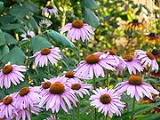
Echinacea angustifolia
Encyclopedia
Echinacea angustifolia
is a herbaceous plant
species
in Asteraceae
. The plants grow 40 to 70 cm (15.7 to 27.6 in) tall with spindle-shaped taproot
s that are often branched. The stem
s and leaves
are moderately to densely hairy.
E. angustifolia blooms late spring to mid summer. It is found growing in dry prairies and barrens
with rocky to sandy-clay soils. There are two subspecies: E. a. angustifolia is native from Saskatchewan
and Manitoba
in the north to New Mexico
, Texas
, and Louisiana
in the south, while E. a. strigosa has a more limited range in Kansas
, Oklahoma
, Texas, and Louisiana.
E. angustifolia is used as a fortifier of the immune system
, mainly to prevent flu and minor respiratory diseases.
Native Americans learned of E. angustifolia by observing elk
seeking out the plants and consuming them when sick or wounded, and identified those plants as "elk root".
is a herbaceous plant
Plant
Plants are living organisms belonging to the kingdom Plantae. Precise definitions of the kingdom vary, but as the term is used here, plants include familiar organisms such as trees, flowers, herbs, bushes, grasses, vines, ferns, mosses, and green algae. The group is also called green plants or...
species
Species
In biology, a species is one of the basic units of biological classification and a taxonomic rank. A species is often defined as a group of organisms capable of interbreeding and producing fertile offspring. While in many cases this definition is adequate, more precise or differing measures are...
in Asteraceae
Asteraceae
The Asteraceae or Compositae , is an exceedingly large and widespread family of vascular plants. The group has more than 22,750 currently accepted species, spread across 1620 genera and 12 subfamilies...
. The plants grow 40 to 70 cm (15.7 to 27.6 in) tall with spindle-shaped taproot
Taproot
A taproot is an enlarged, somewhat straight to tapering plant root that grows vertically downward. It forms a center from which other roots sprout laterally.Plants with taproots are difficult to transplant...
s that are often branched. The stem
Plant stem
A stem is one of two main structural axes of a vascular plant. The stem is normally divided into nodes and internodes, the nodes hold buds which grow into one or more leaves, inflorescence , conifer cones, roots, other stems etc. The internodes distance one node from another...
s and leaves
Leaf
A leaf is an organ of a vascular plant, as defined in botanical terms, and in particular in plant morphology. Foliage is a mass noun that refers to leaves as a feature of plants....
are moderately to densely hairy.
E. angustifolia blooms late spring to mid summer. It is found growing in dry prairies and barrens
Barrens
Barrens may refer to:* Pine barrens, a type of ecosystem found in the Northeastern United States** Pine Barrens , a pine barren in the state of New Jersey...
with rocky to sandy-clay soils. There are two subspecies: E. a. angustifolia is native from Saskatchewan
Saskatchewan
Saskatchewan is a prairie province in Canada, which has an area of . Saskatchewan is bordered on the west by Alberta, on the north by the Northwest Territories, on the east by Manitoba, and on the south by the U.S. states of Montana and North Dakota....
and Manitoba
Manitoba
Manitoba is a Canadian prairie province with an area of . The province has over 110,000 lakes and has a largely continental climate because of its flat topography. Agriculture, mostly concentrated in the fertile southern and western parts of the province, is vital to the province's economy; other...
in the north to New Mexico
New Mexico
New Mexico is a state located in the southwest and western regions of the United States. New Mexico is also usually considered one of the Mountain States. With a population density of 16 per square mile, New Mexico is the sixth-most sparsely inhabited U.S...
, Texas
Texas
Texas is the second largest U.S. state by both area and population, and the largest state by area in the contiguous United States.The name, based on the Caddo word "Tejas" meaning "friends" or "allies", was applied by the Spanish to the Caddo themselves and to the region of their settlement in...
, and Louisiana
Louisiana
Louisiana is a state located in the southern region of the United States of America. Its capital is Baton Rouge and largest city is New Orleans. Louisiana is the only state in the U.S. with political subdivisions termed parishes, which are local governments equivalent to counties...
in the south, while E. a. strigosa has a more limited range in Kansas
Kansas
Kansas is a US state located in the Midwestern United States. It is named after the Kansas River which flows through it, which in turn was named after the Kansa Native American tribe, which inhabited the area. The tribe's name is often said to mean "people of the wind" or "people of the south...
, Oklahoma
Oklahoma
Oklahoma is a state located in the South Central region of the United States of America. With an estimated 3,751,351 residents as of the 2010 census and a land area of 68,667 square miles , Oklahoma is the 28th most populous and 20th-largest state...
, Texas, and Louisiana.
E. angustifolia is used as a fortifier of the immune system
Immune system
An immune system is a system of biological structures and processes within an organism that protects against disease by identifying and killing pathogens and tumor cells. It detects a wide variety of agents, from viruses to parasitic worms, and needs to distinguish them from the organism's own...
, mainly to prevent flu and minor respiratory diseases.
Native Americans learned of E. angustifolia by observing elk
Elk
The Elk is the large deer, also called Cervus canadensis or wapiti, of North America and eastern Asia.Elk may also refer to:Other antlered mammals:...
seeking out the plants and consuming them when sick or wounded, and identified those plants as "elk root".

